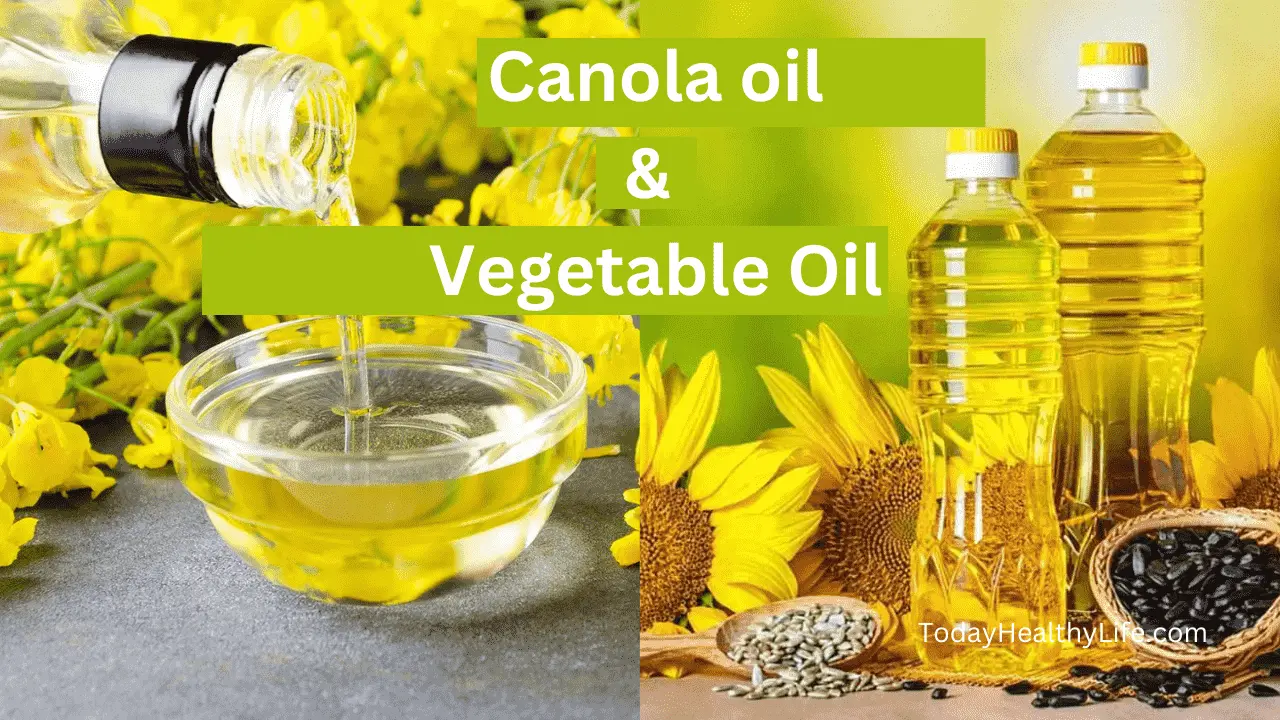In the vast world of cooking oils, two popular choices frequently grace the shelves of grocery stores and occupy kitchen pantries: canola oil and vegetable oil.
Despite their widespread use, many people may not be aware of the distinct characteristics that set these oils apart.
In this comprehensive blog post, we will delve into the differences between canola oil and vegetable oil, exploring their origins, compositions, nutritional profiles, cooking properties, and health considerations.
By understanding the unique features of each oil, you’ll be better equipped to make informed decisions in the kitchen and create healthier, more flavorful meals.

Table of Contents
What’s the Difference Between Canola Oil and Vegetable Oil?
Canola oil and vegetable oil are both plant-based oils that are commonly used in cooking. However, there are some differences between the two oils.
Here are we added some key differences between canola oil and vegetable oil:
Origins and Processing:
Canola Oil:
Canola oil is derived from the seeds of the canola plant, scientifically known as Brassica napus.
The name “canola” is a contraction of “Canadian oil, low acid” and was coined to differentiate it from its predecessor, rapeseed oil.
Developed through selective breeding by Canadian scientists, canola oil is a safer and healthier alternative to traditional rapeseed oil, which contained higher levels of erucic acid and glucosinolates, potentially harmful compounds.
The process of obtaining canola oil involves several steps.
First, the canola seeds are cleaned to remove any impurities.
Next, the seeds are crushed, and the oil is extracted.
The extracted oil then goes through a refining process to remove any remaining impurities and improve its shelf life.
The final product is a clear, light-textured oil with a mild flavor, making it an excellent all-purpose cooking oil.
You may also read about:
- Why Is Canola Oil Banned In Europe? – Actual Reason.
- Corn Oil vs Canola Oil: Key Differences & Which is Right for You?
Vegetable Oil:
Vegetable oil is a broad term used to describe a blend of various plant-based oils. The composition of vegetable oil can vary widely, depending on the oils included in the blend.
Common sources for vegetable oil include soybeans, sunflower seeds, corn, safflower, palm fruit, and more.
It is essential to note that not all vegetable oils are the same, and their nutritional profiles can differ significantly.
The production process of vegetable oil involves extracting the oils from the respective plants.
There are various methods for oil extraction, including mechanical pressing and solvent extraction.
After extraction, the oils may undergo further refining to remove impurities and enhance their stability.
The resulting vegetable oil is typically pale in color and has a neutral flavor, making it suitable for a wide range of cooking applications.
Nutritional Profile:
Canola Oil:
Canola oil has gained popularity for its favorable nutritional profile, making it one of the healthier cooking oil choices.
It is predominantly composed of monounsaturated fats, with oleic acid (omega-9) being the most abundant.
Monounsaturated fats are known for their heart-healthy properties and are also found in olive oil.
Canola oil also contains a balanced amount of polyunsaturated fats, primarily linoleic acid (omega-6), which is essential for various bodily functions.
One of the key differentiators of canola oil is its significant content of alpha-linolenic acid (ALA), an essential omega-3 fatty acid.
ALA is beneficial for heart health and is known to reduce inflammation and support overall well-being.
Additionally, canola oil has a relatively low amount of saturated fats, making it a healthier option compared to oils higher in saturated fats.
Vegetable Oil:
The nutritional profile of vegetable oil can vary significantly based on the specific oils included in the blend.
Some vegetable oil blends may closely resemble canola oil in terms of their fatty acid composition, with a substantial amount of monounsaturated and polyunsaturated fats.
In such cases, the presence of ALA from oils like flaxseed or soybean oil can also contribute to heart-healthy benefits.
However, not all vegetable oil blends are created equal. Some may have a higher proportion of less desirable saturated fats, which can contribute to elevated LDL cholesterol levels when consumed in excess.
For this reason, it is crucial for consumers to read labels and choose vegetable oil blends that prioritize a healthy balance of unsaturated fats.
Here is a nutritional difference table between canola oil and vegetable oil:
| Nutrient | Canola Oil | Vegetable Oil |
|---|---|---|
| Calories | 124 | 117 |
| Fat | 14 g | 13.6 g |
| Saturated fat | 1 g | 11 g |
| Monounsaturated fat | 9 g | 10 g |
| Polyunsaturated fat | 4 g | 2.6 g |
| Omega-3 fatty acids | 0.2 g | 0.1 g |
| Vitamin E | 16% DV | 12% DV |
| Vitamin K | 8% DV | 7% DV |
Smoke Point and Cooking Properties:
Canola Oil:
The smoke point of an oil is the temperature at which it starts to produce visible smoke during heating.
Beyond this point, the oil begins to break down, releasing harmful compounds and affecting both the flavor and nutritional value of the food being cooked.
Canola oil boasts a relatively high smoke point of around 400°F (204°C). This high smoke point makes it suitable for a wide range of cooking methods, including sautéing, baking, grilling, and deep-frying.
Vegetable Oil:
As mentioned earlier, the smoke point of vegetable oil can vary depending on the specific oils blended to create it.
Here are some examples of vegetable oils and their respective smoke points:
- Sunflower Oil: Sunflower oil is commonly used in cooking and has a high smoke point, usually around 440°F (227°C). This makes it suitable for high-heat cooking methods such as frying and sautéing.
- Safflower Oil: Safflower oil is another oil with a high smoke point, typically around 450°F (232°C). Like sunflower oil, it is ideal for high-temperature cooking techniques.
- Soybean Oil: Soybean oil has a moderate smoke point of approximately 350°F (177°C), making it suitable for a range of cooking methods, including baking, sautéing, and stir-frying.
- Corn Oil: Corn oil also has a moderate smoke point, generally around 410°F (210°C), making it versatile for various cooking applications.
- Flaxseed Oil: Flaxseed oil, which is rich in ALA (omega-3 fatty acid), has a relatively low smoke point of about 225°F (107°C). Due to its low smoke point, it is best used in cold dishes and dressings.
- Olive Oil: While not typically considered a vegetable oil, it’s essential to mention that olive oil has a lower smoke point than most vegetable oils. Extra virgin olive oil has a smoke point of approximately 375°F (190°C), making it suitable for low to medium-heat cooking and for drizzling over salads and dishes.
Health Considerations:
Canola Oil:

Canola oil’s favorable fatty acid composition has led to numerous health benefits.
The high content of monounsaturated fats, particularly oleic acid, helps to reduce LDL cholesterol levels while maintaining or even increasing HDL cholesterol levels, thus promoting heart health.
The significant presence of ALA, an omega-3 fatty acid, provides anti-inflammatory properties and supports brain function.
The balance of omega-3 and omega-6 fatty acids is essential for overall health, as these fats play critical roles in various bodily functions.
Additionally, canola oil contains vitamin E, an antioxidant that protects cells from oxidative damage, and phytosterols, which may help lower cholesterol levels.
The oil’s low saturated fat content further contributes to its heart-healthy reputation.
Vegetable Oil:
The health implications of vegetable oil depend on the specific oils used in the blend.
When the composition of vegetable oil aligns with canola oil, offering a balance of monounsaturated and polyunsaturated fats, it can provide similar heart-healthy benefits.
The inclusion of oils high in ALA, such as flaxseed or soybean oil, can add further value in terms of anti-inflammatory properties.
However, it is essential to be cautious of vegetable oil blends that contain higher levels of saturated fats.
Excessive consumption of saturated fats can contribute to increased LDL cholesterol levels, increasing the risk of heart disease and other health issues.
To ensure the healthiest option, consumers should select vegetable oil blends that prioritize a balance of unsaturated fats, such as monounsaturated and polyunsaturated fats.
Culinary Applications and Flavor Profile:
Canola Oil:
Canola oil’s mild flavor and neutral taste make it a versatile cooking oil that complements a wide range of dishes.
Its ability to withstand high temperatures without smoking or breaking down makes it suitable for various cooking methods.
Canola oil works well for sautéing vegetables, frying chicken, baking moist and tender cakes, and grilling meats to perfection.
Its subtle taste also makes canola oil an excellent choice for salad dressings, marinades, and homemade mayonnaise.
It allows the other flavors in a dish to shine without overpowering them with its own taste, making it a preferred option for those seeking a more delicate and balanced flavor profile in their dishes.
Vegetable Oil:
The flavor profile of vegetable oil is similar to that of canola oil – mild and neutral. This characteristic makes vegetable oil equally versatile in the kitchen and appropriate for various cooking techniques.
Just like canola oil, it can handle high-heat cooking methods, including frying and sautéing, without imparting an overwhelming taste to the food.
The neutral flavor of vegetable oil makes it a popular choice for baking, ensuring that the natural flavors of the ingredients take center stage in cakes, muffins, and cookies.
Additionally, its ability to blend seamlessly with other ingredients in dressings and marinades makes it a go-to option for those who want to infuse their dishes with other flavors without altering the overall taste.
Shelf Life and Storage:
Canola Oil:
Canola oil has a reasonably long shelf life when stored properly. As with all cooking oils, exposure to light, heat, and air can lead to oxidation and rancidity.
To extend the shelf life of canola oil, it is best to store it in a cool, dark place, away from direct sunlight and heat sources.
Vegetable Oil:
The shelf life of vegetable oil can vary depending on the oils included in the blend.
Some vegetable oils with higher amounts of saturated fats may have a longer shelf life, while those with higher polyunsaturated fat content may be more susceptible to oxidation.
Regardless of the blend, proper storage in a cool, dark place is essential to maintain the quality and freshness of the oil.
Environmental Considerations:
Canola Oil:
Canola oil is considered to be relatively environmentally friendly compared to certain other oils.
The canola plant has a lower environmental impact in terms of water and energy consumption during cultivation.
Additionally, canola oil production generates less waste and by-products compared to some other cooking oils, making it a more sustainable option.
Vegetable Oil:
The environmental impact of vegetable oil depends on the specific oils used in the blend and the practices employed during production.
For instance, palm oil, a common component of vegetable oil blends, has been associated with deforestation and habitat destruction in certain regions.
As a conscious consumer, choosing vegetable oil blends that prioritize sustainability and responsible sourcing can help mitigate these environmental concerns.
Related FAQs:
The main difference lies in their sources and composition. Canola oil is derived from the canola plant, while vegetable oil is a blend of various plant-based oils, which may include soybean, sunflower, corn, safflower, and palm oils, among others.
Canola oil is often considered healthier due to its favorable fatty acid composition, with a higher content of monounsaturated fats and a significant presence of ALA (omega-3 fatty acid).
However, some vegetable oil blends can be equally healthy if they contain a similar balance of unsaturated fats and essential fatty acids.
Yes, in most recipes, you can use canola oil and vegetable oil interchangeably without significantly affecting the outcome.
Both oils have a neutral flavor and can complement a wide range of dishes.
Both canola oil and certain vegetable oil blends, such as sunflower and safflower oil, have high smoke points suitable for frying. You can use either of these oils for deep-frying or pan-frying to achieve crispy and delicious results.
Both canola oil and vegetable oil have a mild and neutral taste, allowing the natural flavors of the ingredients to shine through.
However, some vegetable oils, like olive oil or peanut oil, have distinct flavors that may impart their taste to the dishes.
For salad dressings and drizzling, oils with lower smoke points, such as extra virgin olive oil or flaxseed oil, are better suited.
Their delicate flavors and nutritional benefits make them ideal choices for adding the finishing touch to your dishes.
Yes, you can substitute canola oil with vegetable oil in baking recipes. Both oils have a neutral flavor and similar composition, making them suitable replacements for each other in most baking applications.
Canola oil production is considered relatively environmentally friendly, as the canola plant is a sustainable crop requiring fewer pesticides and herbicides.
However, some vegetable oils, like palm oil, have been associated with deforestation and habitat destruction.
Choosing vegetable oil blends with sustainable sourcing practices can help mitigate environmental impacts.
Yes, both canola oil and certain vegetable oil blends can contribute to a heart-healthy diet when consumed in moderation. Their favorable fatty acid profiles, including monounsaturated and polyunsaturated fats, can help lower LDL cholesterol levels and support heart health.
The cost-effectiveness of canola oil and vegetable oil can vary depending on the brand and region. In general, vegetable oil blends may be more affordable due to their wider range of sources, but specific prices may fluctuate based on market conditions.
Conclusion
So, what’s the difference between canola oil and vegetable oil? Both canola oil and vegetable oil are widely used as cooking oils with their unique origins, compositions, nutritional profiles, cooking properties, and health considerations.
Canola oil, derived from the canola plant, is celebrated for its heart-healthy fatty acid composition, substantial ALA content, and high smoke point.
Its mild flavor and versatility make it an excellent all-purpose cooking oil.
Vegetable oil, a blend of various plant-based oils, can offer similar health benefits when composed of favorable fatty acids.
Its neutral flavor and ability to withstand high temperatures make it equally versatile in the kitchen.
When choosing between canola oil and vegetable oil, consider your health needs, culinary preferences, and intended cooking methods.
For heart-healthy benefits, canola oil is a preferred choice, but vegetable oil can be just as nutritious when its blend aligns with your dietary goals.
Remember, both oils should be used in moderation as part of a balanced diet.
By making conscious choices and incorporating these healthy cooking oils into your culinary adventures, you can elevate your dishes’ flavors while promoting overall well-being.
Embrace the diversity of cooking oils available to you, and let your creativity and culinary expertise flourish in the kitchen. Happy cooking!

